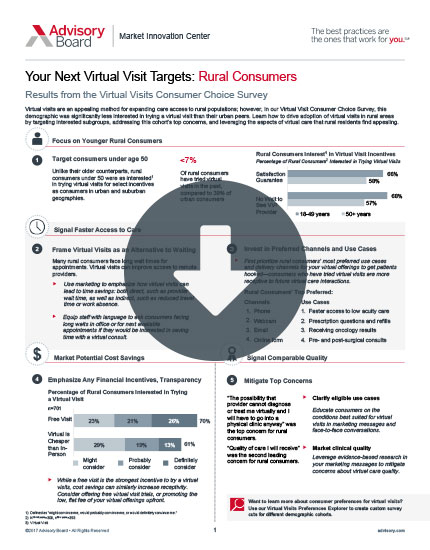Auto logout in seconds.
Continue LogoutAs more rural hospitals close, health care delivery in rural areas must evolve to better address the unique challenges of providing care at low volumes, according to report by the Bipartisan Policy Center and the Center for Outcomes Research and Education.
Census Bureau data released in 2016 show 19.3% of the U.S. population lived in rural areas, which make up 97% of the geographic area of the country. According to NPR's "Shots," individuals living in those areas typically are served by federally funded medical facilities, including about 1,300 critical access hospitals (CAHs).
But many of those hospitals are struggling, "Shots" reports. According to the National Rural Health Association, 60 rural hospitals shut down between 2010 and February 2016, and currently, 673 more are at risk of closure.
Rural health care's unique challenges
Heidi Schultz, who oversees Helmsley Charitable Trust's rural health program for seven Upper Midwestern states, attributed the closures in part to the low volume of patients in rural areas. "Think of a 25-bed hospital, and you're only using four of your beds and how expensive that is," she said.
Other challenges affecting rural health care delivery include limited access to reliable transportation and broadband internet connection, regulatory restrictions, and a unique patient population, according to Anand Parekh, chief medical advisor with the Bipartisan Policy Center. Parekh said, "Rural America is a little bit older, a little bit sicker, a little bit poorer."
Report pushes for change
In a report published last month, Parekh and colleagues said policymakers and communities should re-evaluate the current rural health care model, which relies in part on federally funded CAHs, and craft new models around the individual needs of each community. In some cases, that could mean closing a struggling community hospital and replacing it with an outpatient clinic, urgent care center, or other type of care that better meets a community's resources and needs.
Darrold Bertsch, CEO of Sakakawea Medical Center in North Dakota, said, "If communities had a little bit more flexibility, then they could adapt a health care delivery system in their area that is more relevant to the needs that they have, rather than trying to make a hospital fit in a community where it might not be able to be supported anymore."
As Schultz said, "There's been a fear in the air and you read a lot, and you hear a lot about hospitals closing. ... [A]nd that's rightfully so. But if you look at the communities that are losing their hospitals, you need to look at, 'What do they still have?'"
Innovative solutions in practice
Some rural communities already have taken outside-the-box approaches to maintain access to care, "Shots" reports.
For instance, when the CAH serving Tilden, Nebraska—a small town with fewer than 1,000 residents—closed in 2014, the town reached an agreement with Faith Regional Health Services, located 22 miles away, to lease the hospital. Under the agreement, Faith Regional oversees equipment maintenance, staffing, and providers for the facility—but it is no longer a full-service hospital, "Shots" reports.
Patrick Roche, COO at Faith Regional Health Services, said, "The operations are, in effect, owned by Faith Regional and are operated just like any other clinic that is owned and operated by our system."
In Cody, Wyoming—a town of with about 10,000 residents—Cody Regional Health was able to keep its CAH open by adapting to change, according to Jeanine Brus, the hospital's laboratory director. The hospital serves the town, as well as tourists from Yellowstone National Park and farms and ranches in a 200-mile radius. Brus says the key has been to improve coordination and collaboration among the hospital and Cody Regional's other health care facilities.
As Parekh said, "You know, you don't have to close your hospital. ... [Y]ou can transform the hospital to meet your community needs, improve health and still continue to improve your local economy" (St. Clair, "Shots," NPR/Kaiser Health News, 2/28; Marketplace, 2/2; Bryant, Healthcare DIVE, 1/18).
Mar. 21 webcon: How can your organization forge sustainable community partnerships to address social determinants of health?
Join us on Wednesday, Mar. 21 at 1 pm ET to learn how the University of Vermont Medical Center developed sustainable partnerships with multiple community-based organizations to address their patients’ unmet housing and health care needs.
Don't miss out on the latest Advisory Board insights
Create your free account to access 1 resource, including the latest research and webinars.
Want access without creating an account?
You have 1 free members-only resource remaining this month.
1 free members-only resources remaining
1 free members-only resources remaining
You've reached your limit of free insights
Become a member to access all of Advisory Board's resources, events, and experts
Never miss out on the latest innovative health care content tailored to you.
Benefits include:
You've reached your limit of free insights
Become a member to access all of Advisory Board's resources, events, and experts
Never miss out on the latest innovative health care content tailored to you.
Benefits include:
This content is available through your Curated Research partnership with Advisory Board. Click on ‘view this resource’ to read the full piece
Email ask@advisory.com to learn more
Click on ‘Become a Member’ to learn about the benefits of a Full-Access partnership with Advisory Board
Never miss out on the latest innovative health care content tailored to you.
Benefits Include:
This is for members only. Learn more.
Click on ‘Become a Member’ to learn about the benefits of a Full-Access partnership with Advisory Board
Never miss out on the latest innovative health care content tailored to you.

